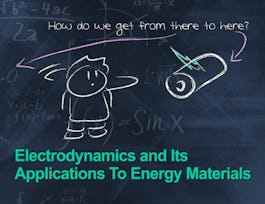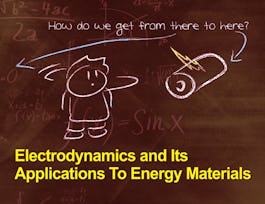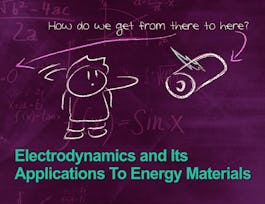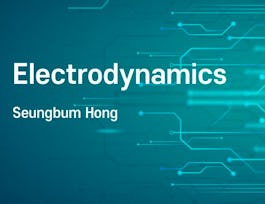The depth and breadth of electromagnetism, the foundation for many fields including materials science, electrical engineering, and physical chemistry, requires a long, steep, and steady learning curve. This course aims to bridge the gap between the fundamental principles taught in electromagnetism and its practical application to specific fields such as materials, physics, and chemistry related to energy storage and harvesting.


Electrodynamics: An Introduction
This course is part of Electrodynamics Specialization
Taught in English
Some content may not be translated

Instructor: Seungbum Hong
34,449 already enrolled
Included with 
Course
(603 reviews)
Details to know

Add to your LinkedIn profile
5 quizzes
Course
(603 reviews)
See how employees at top companies are mastering in-demand skills

Build your subject-matter expertise
- Learn new concepts from industry experts
- Gain a foundational understanding of a subject or tool
- Develop job-relevant skills with hands-on projects
- Earn a shareable career certificate


Earn a career certificate
Add this credential to your LinkedIn profile, resume, or CV
Share it on social media and in your performance review

There are 5 modules in this course
In this module, electrodynamics is introduced by examining the different forces and explaining which are related to electric forces. Furthermore, fields are defined and we differentiate between scalar and vector fields. We cover laws that constitute electrodynamics, specifically Maxwell's equations and the Lorentz force. After explaining how these topics can be illustrated, we also cover how relativity relates to the subject material.
What's included
3 videos2 readings1 quiz
This module mainly covers the mathematics behind differential forms of equations. We introduce the ∇ operator and show how it can be used in mathematics. Then, the ∇ operator is proved to be a vector. The Maxwell equations are rewritten in derivative form, and the concepts of divergence and curl are introduced. Finally, we examine the Laplace operator, and other forms of the ∇ operator applied twice.
What's included
2 videos1 reading1 quiz
This module explains line integrals and presents some equations where they are important. We explain what the flux and circulation of a field are conceptually and how they can be obtain using the divergence and curl through Gauss' and Stokes' theorems respectively. Finally, we explain the qualities of divergence and curl free fields.
What's included
2 videos1 reading1 quiz
This module covers how to simplify Maxwell's equations in the scenario of electrostatics. Then, we discuss how the electric potential can be used and why using a relative value is useful for certain calculations. The flux out of different geometries is presented, as well as how to display field lines and equipotential surfaces.
What's included
2 videos1 reading1 quiz
This module focusses primarily on electric fields. First, we talk about the mathematical requirements for equilibrium and the implications of finding equilibrium for point charges. Then we move on to describe the electric field coming from different geometries. Finally, we compare the electric fields inside and outside of a conductor and how they create the phenomenon of electric shielding.
What's included
3 videos1 reading1 quiz
Instructor

Recommended if you're interested in Electrical Engineering

Korea Advanced Institute of Science and Technology(KAIST)

Korea Advanced Institute of Science and Technology(KAIST)

Korea Advanced Institute of Science and Technology(KAIST)

Korea Advanced Institute of Science and Technology(KAIST)
Why people choose Coursera for their career




Learner reviews
Showing 3 of 603
603 reviews
- 5 stars
74.38%
- 4 stars
20.66%
- 3 stars
2.80%
- 2 stars
1.15%
- 1 star
0.99%

Open new doors with Coursera Plus
Unlimited access to 7,000+ world-class courses, hands-on projects, and job-ready certificate programs - all included in your subscription
Advance your career with an online degree
Earn a degree from world-class universities - 100% online
Join over 3,400 global companies that choose Coursera for Business
Upskill your employees to excel in the digital economy
Frequently asked questions
Access to lectures and assignments depends on your type of enrollment. If you take a course in audit mode, you will be able to see most course materials for free. To access graded assignments and to earn a Certificate, you will need to purchase the Certificate experience, during or after your audit. If you don't see the audit option:
The course may not offer an audit option. You can try a Free Trial instead, or apply for Financial Aid.
The course may offer 'Full Course, No Certificate' instead. This option lets you see all course materials, submit required assessments, and get a final grade. This also means that you will not be able to purchase a Certificate experience.
When you enroll in the course, you get access to all of the courses in the Specialization, and you earn a certificate when you complete the work. Your electronic Certificate will be added to your Accomplishments page - from there, you can print your Certificate or add it to your LinkedIn profile. If you only want to read and view the course content, you can audit the course for free.
If you subscribed, you get a 7-day free trial during which you can cancel at no penalty. After that, we don’t give refunds, but you can cancel your subscription at any time. See our full refund policy.

